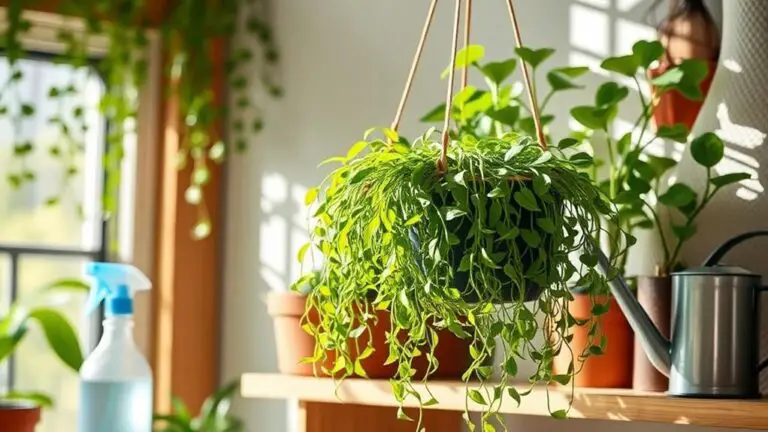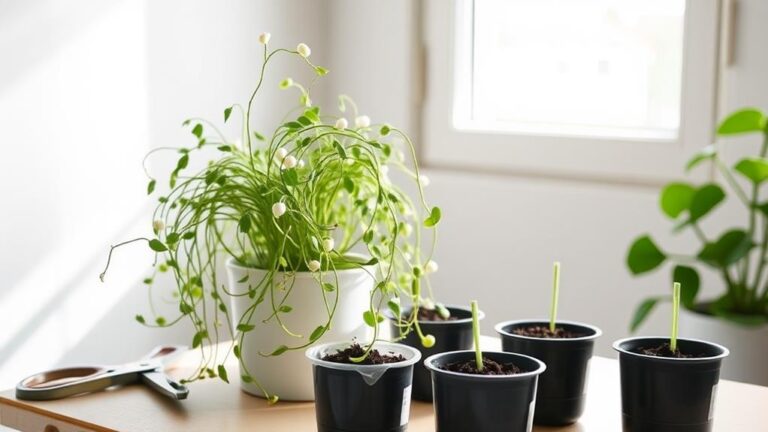Help My Succulent Is Dying: A Step-by-Step Guide
You've noticed your succulent isn't looking as vibrant as it used to, and you're wondering what went wrong. Is it overwatering, underwatering, or perhaps something else? Identifying the root cause is key to reviving your plant. In this guide, you'll find step-by-step solutions to common issues like yellow leaves, root rot, and shriveled foliage. We'll also cover how to handle pests and guarantee your succulent gets the right amount of light. Before you give up on your plant, let's explore what you can do to bring it back to life.
Recognizing Common Issues

Recognizing common issues in your succulent is fundamental for its survival. You might notice yellow leaves, a classic sign of overwatering, which can lead to root rot if not addressed. Check the soil; if it's waterlogged and clumps together, your plant's roots are likely suffocating. Confirm your pot has drainage holes to prevent this problem.
Another issue is leaf burn from too much sunlight, leaving bleached patches that won't heal. Trim these areas carefully to maintain your plant's health.
Be mindful of pests like mealybugs and spider mites. They create webbing and cottony masses on leaves, stressing your succulent. Prompt treatment is imperative to prevent further damage.
Environmental factors are also significant. Inadequate light can weaken your plant, causing it to stretch and become leggy.
Temperature fluctuations and high humidity can further stress your succulent, making regular monitoring essential. Adjust your plant's environment to provide consistent light and moderate humidity levels.
Diagnosing Overwatering
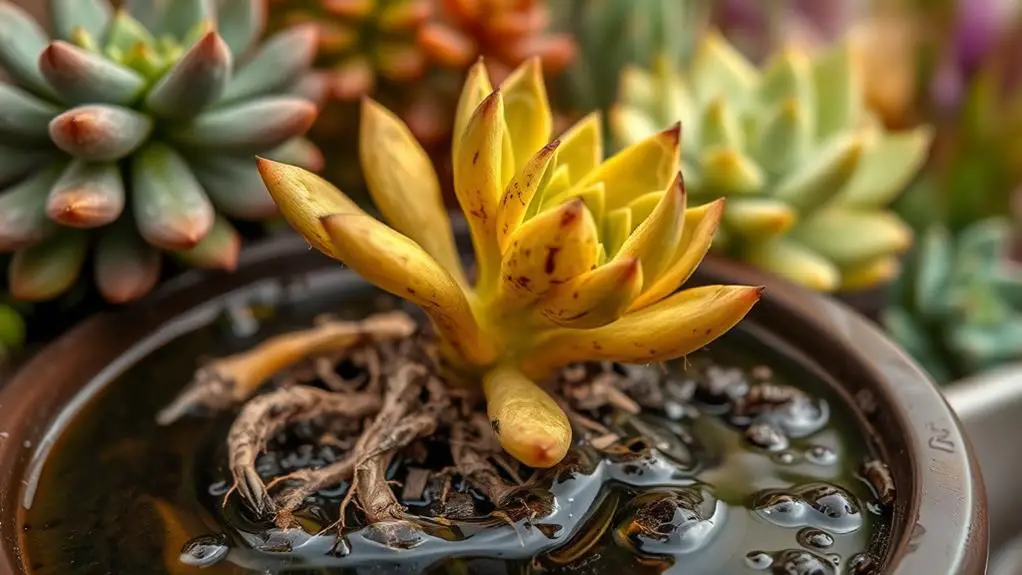
If your succulent's soil feels wet and clumpy, it might be suffering from overwatering.
Look for yellow, soft, or squishy leaves that fall off easily, as these are clear signs.
To fix this, check the roots for mushiness and let the soil dry out thoroughly before watering again.
Common Overwatering Symptoms
When your succulent starts showing yellowing leaves that turn soft and mushy, it's often a telltale sign of overwatering. An overwatered succulent usually displays several key symptoms that are easy to identify once you know what to look for.
First, check for waterlogged soil. If the soil clumps together rather than having separate grains, your plant is likely drowning in too much moisture. Additionally, leaves that fall off with just a slight touch indicate stress from overwatering.
You might also see browning or blackening of leaves, which signals potential root rot or fungal disease. These issues occur when the roots sit in water for too long, causing them to decay.
Another serious sign is translucent leaves and stems. This transparency shows that the plant is suffering severe root damage and can't absorb water properly anymore.
Here are some common overwatering symptoms to watch for:
- Yellowing leaves that turn soft and mushy
- Waterlogged soil that clumps together
- Leaves that easily drop off
- Browning or blackening of leaves
Recognizing these signs of overwatering can help you address the problem before it's too late. Keep an eye on your succulent and adjust watering habits as needed to keep it healthy.
Immediate Corrective Actions
Having identified the symptoms of overwatering, it's time to take immediate corrective actions to save your succulent.
First, check the soil. Healthy succulent soil should be dry and grainy, not clumpy or waterlogged. If you see clumps, your plant is sitting in too much moisture.
Gently remove the plant from its pot and examine the roots. Healthy roots are white, while overwatered ones might be brown and mushy.
If you notice root rot, carefully prune away the affected roots. Be gentle to avoid further damage.
Next, let the succulent air dry for 2-3 days. This step is essential to help the plant recover from the excess moisture.
Once dry, replant it in fresh succulent soil. Make certain this new soil mix has good drainage properties to prevent water retention.
Choose a pot with adequate drainage holes to guarantee excess water can escape. This helps avoid future overwatering issues.
When replanting, make certain the leaves and stems are above the soil line to prevent further rot.
Following these steps can revive your succulent and set it on the path to recovery.
Saving Overwatered Succulents
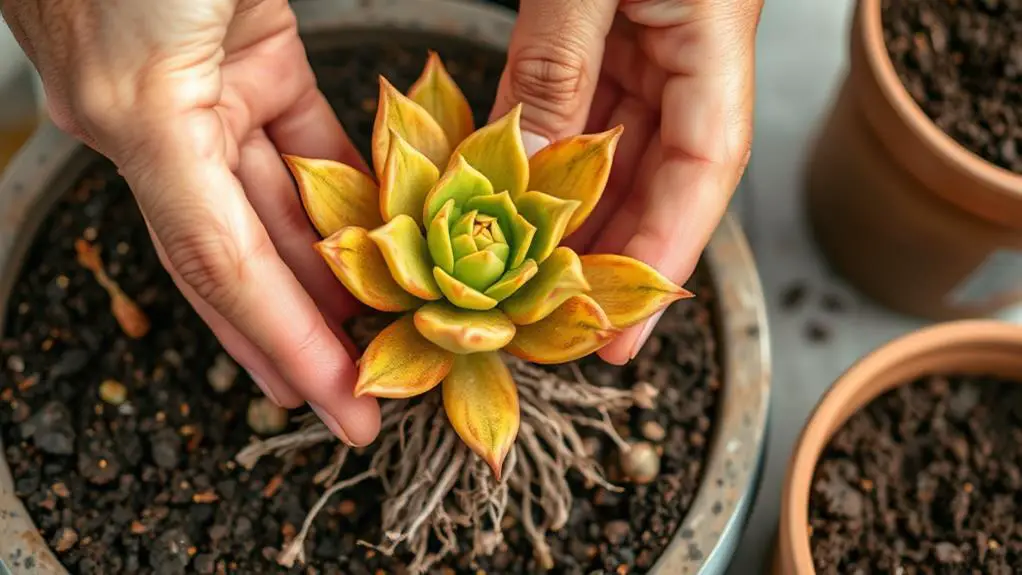
If your succulent shows symptoms of overwatering, like yellowing leaves and mushy roots, act quickly to save it.
Remove the plant from its pot, trim away any rotted roots, and let the healthy parts air dry for a few days.
Repot it in fresh, well-draining soil and place it in a shaded area, watering only when the soil is completely dry.
Identifying Overwatering Symptoms
Overwatered succulents often signal their distress through various symptoms that are easy to spot if you know what to look for.
When a succulent gets too much water, its leaves can turn yellow and feel soft and mushy. This is one of the first signs that the plant isn't happy.
You might also notice that the soil is waterlogged, appearing clumpy and not draining properly. This can lead to root rot, which is a serious problem for succulents.
If you touch the plant and the leaves drop off easily, that's another sign of overwatering stress. Advanced symptoms include leaves turning browning or blackened, which indicates severe rot or possibly a fungal disease.
To help you identify these symptoms more easily, here's a quick list:
- Soft and mushy leaves: Yellowing and mushy to the touch.
- Waterlogged soil: Clumpy soil that doesn't drain well.
- Translucent leaves and mushy stems: Signs of early overwatering.
- Browning or blackened leaves: Severe rot or fungal issues.
Regularly checking for these signs can help you catch problems early and save your succulent.
Revival Techniques Explained
When you've identified that your succulent is suffering from overwatering, immediate action is vital to save it. Start by carefully removing the plant from its pot to check the roots. Look for healthy white roots and prune away any brown, mushy ones affected by root rot caused by overwatering. Allow the healthy roots to air dry for 2-3 days.
Next, replant your succulent in fresh, well-draining succulent soil. This step is important to provide a new environment where the plant can thrive. Make sure to change the top layer of soil to eliminate any algae or moisture retention.
| Step | Action |
|---|---|
| 1. Remove Plant | Check root health and prune rotten roots |
| 2. Air Dry Roots | Let healthy roots dry for 2-3 days |
| 3. Replant | Use well-draining succulent soil |
| 4. Avoid Sunlight | Keep in shaded area until signs of recovery |
After you've repotted the succulent, place it in a shaded area to reduce stress and avoid direct sunlight until it starts showing signs of recovery. It's important to monitor the soil moisture closely. Only water the repotted succulent when the soil has completely dried out to prevent future overwatering issues. With patience and care, you can revive a succulent dying from overwatering.
Preventing Overwatering

Preventing overwatering is essential to keeping your succulent healthy and thriving. To start, always use a well-draining potting mix designed for succulents. This mix should include potting soil, perlite, and sand to guarantee proper drainage, preventing excess moisture around the roots.
Make sure your pots have adequate drainage holes. These holes let extra water escape, avoiding stagnant water that can lead to root rot. Before watering, check the soil's moisture level. Wait until the top inch of soil is completely dry to the touch before adding water. This simple step helps you avoid overwatering and keeps your succulent happy.
Using larger pots with gravel or expanded shale at the bottom can also improve drainage. These materials prevent water from sitting near the roots, which can cause damage. Adjust your watering frequency based on the succulent's growth season. They need more water during active growth in spring and summer, and less during dormancy in fall and winter.
Here are some key tips:
- Use well-draining potting mix with potting soil, perlite, and sand.
- Guarantee pots have drainage holes to avoid stagnant water.
- Check soil moisture before watering; wait until top inch is dry.
- Use larger pots with gravel or expanded shale for better drainage.
Diagnosing Underwatering

Your succulent's shriveled leaves and dull appearance might be clear indicators of underwatering. When succulents need more water, their leaves can become wrinkled and lose their vibrant color. If you touch the soil and it feels completely dry, that's another strong sign your plant is thirsty.
Sometimes, the soil can even become hydrophobic, meaning it repels water instead of absorbing it. You might also notice brown tips or edges on the leaves of your underwatered succulent. These brown tips are a sign of dehydration and mean your plant needs attention.
To revive a dying succulent, keep in mind that you shouldn't start watering immediately with excess water. Instead, gradually introduce moisture to the soil to avoid shocking the plant.
Regularly checking the moisture level in the soil is essential. Succulents need just the right amount of water to thrive, not too much and not too little.
Saving Underwatered Succulents

A succulent's survival often hinges on how quickly and effectively you address underwatering. When your succulent's leaves appear wrinkled and shriveled, it's a clear sign they lack moisture.
Start by gradually rehydrating the plant. A deep soaking method or bottom watering works best, allowing the roots to absorb water without overwhelming them.
If the soil has become hydrophobic from prolonged dryness, gently loosen the top layer. This helps water penetrate more easily during future watering sessions.
Always check if the soil is dry to the touch before watering again to prevent future underwatering.
For severely underwatered succulents, you might need to contemplate propagating healthy stem sections. Trim away any damaged parts and let the cut ends callus before replanting them in suitable soil.
Here's a quick guide to help you:
- Deep Soaking Method: Submerge the pot in water and let it soak up moisture.
- Bottom Watering: Place the pot in a tray of water and let the soil absorb it from the bottom.
- Loosen Soil: Gently break up the dry top layer to improve water absorption.
- Propagation: Trim healthy stems, let them callus, and replant.
Dealing With Leaf Burn
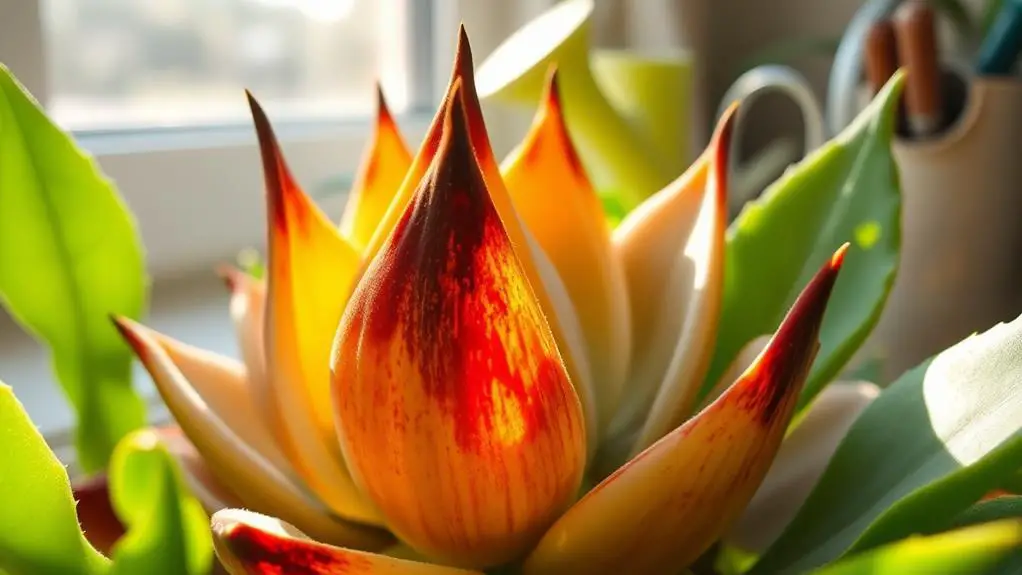
Overexposure to direct sunlight often leads to leaf burn in succulents, marked by bleached or discolored patches on their leaves. If you notice this on your succulent, it's essential to act quickly. Excessive direct sunlight can damage the leaves, and unfortunately, they can't heal. You'll need to trim them off with clean scissors to reduce stress on the plant.
Next, move your succulent to a bright area where it can get indirect sunlight. This will prevent further damage and give your plant a chance to recover. Remember, succulents need some light, but too much direct exposure can be harmful.
Regularly monitoring for signs of recovery is important. Succulents might take a while to bounce back, so be patient and keep an eye on them.
Make sure your plant has good air circulation. This helps prevent leaf burn and keeps the plant healthy.
Also, maintaining proper humidity levels around your succulent can protect it from future leaf burn.
Managing Pests

Battling pests is an integral part of succulent care that shouldn't be overlooked. Regularly inspecting your succulents for common pests like mealybugs, spider mites, and scale is vital. Early detection allows you to manage infestations before they get out of hand.
If you spot mealybugs or scale, use a cotton swab dipped in rubbing alcohol to treat the affected areas. This method can eliminate these pests without harming your plant. For spider mites and other pests, apply insecticidal soap. Be certain to cover both the tops and undersides of the leaves thoroughly.
Consistency is key, so repeat pest treatments weekly for four to six weeks to guarantee you eradicate any remaining pests.
Don't forget to quarantine infested plants. This step prevents pests from spreading to your healthy succulents. Keep a close eye on the surrounding plants and monitor them for any signs of infestation.
Here's a quick checklist to help you manage pests effectively:
- Inspect: Regularly check your succulents for pests.
- Treat: Use a cotton swab with rubbing alcohol for mealybugs and scale.
- Apply: Use insecticidal soap for spider mites.
- Quarantine: Isolate infested plants and monitor others.
General Care Tips
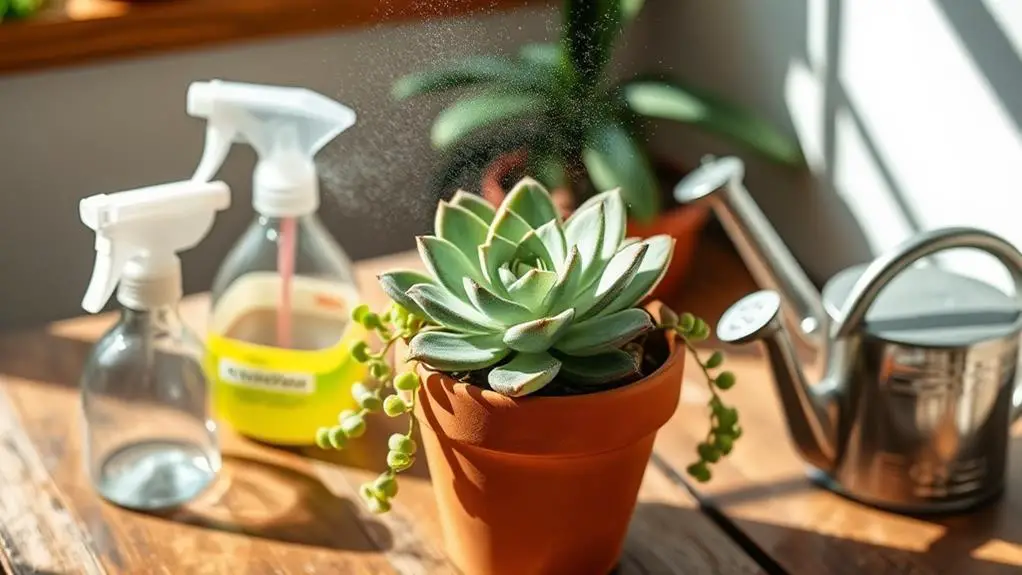
Caring for your succulents involves paying close attention to their specific needs to ensure they thrive.
First, make certain you're using well-draining soil. A good mix includes 16-17% perlite, 32-34% sand, and 48-49% potting soil. This prevents water retention, which can cause root rot.
Watering is another critical aspect. Only water your succulents when the top inch of soil is completely dry. This might mean watering less frequently in winter and more often in summer. Always adjust based on the plant's needs to provide the right amount of water.
Lighting matters too. Place your succulents in bright, indirect light—near south or west-facing windows works best. This way, they get enough sunlight without getting sunburned.
Humidity levels should be between 40-60%. Too much humidity can lead to fungal issues and pests, which are common problems for succulents.
Keep an eye on your plants for yellowing leaves or mushy stems, signs they might need help. If you notice these issues, repot in fresh soil to give your plant a fresh start.
Regularly inspect your succulents to catch problems early and keep them healthy and happy.
Frequently Asked Questions
How Do You Revive a Dying Succulent?
First, check for yellow leaves or mushy stems. If overwatered, remove the plant, trim rotted roots, and let them dry. For underwatered succulents, soak the soil. Repot with well-draining soil and provide indirect light.
What Does an Overwatered Succulent Look Like?
An overwatered succulent shows yellowing, squishy leaves, and waterlogged soil. Leaves may drop easily, and advanced symptoms include browning or blackening leaves and mushy stems. These signs indicate stress and potential root rot or fungal disease.
Should I Cut off Dying Succulent Leaves?
Yes, you should cut off dying succulent leaves. Use clean, sharp scissors or pruning shears to remove them. This helps redirect energy to healthier parts, promoting new growth and preventing rot from spreading to the healthy plant sections.
Should I Remove Damaged Succulent Leaves?
Yes, you should remove damaged succulent leaves. Cutting off yellow, brown, or mushy leaves with clean, sterilized shears prevents disease spread and stress. Regularly inspect your plant to encourage new growth and maintain its health.
Conclusion
You've got this! By recognizing common issues and knowing how to address them, you're well-equipped to save your succulent. Whether it's overwatering, underwatering, pests, or leaf burn, you now have the steps to identify and fix these problems. Remember to check the soil, monitor light, and keep an eye out for pests. With careful attention and the right actions, your succulent will thrive again. Keep going, and don't give up—your plant's health is in your hands!


